Dots - in - Stitch
PRODUCT DESIGN / PEDAGOGY / INCLUSIVE DESIGN
Dots-in-Stitch merges Braille learning with stitching, blending the joy of crafting with tactile literacy. This approach enables students to master a new language while enhancing cognitive skills and empathy. By engaging in this creative exploration, students gain insights into accessibility design and inclusive education, preparing them for a compassionate and adaptable future.
TYPE
Product (Prototype)
DURATION
2 Weeks
USER
8th-grade students aged 12 to 14 at Resurrection High School.
TOOLS
Adobe Illustrator
Canva

Project Overview
Problem Statement
How can we transform stitching from a student course into a meaningful tool for fostering inclusivity and tactile literacy, especially with the integration of Braille?
Goal
The primary goal of this project is to promote inclusivity and accessibility by integrating tactile learning, specifically Braille, into creative activities such as sewing. This approach aims to empower all students, regardless of their background or abilities, while providing them with valuable life skills.
Process
(Click on the element to navigate to the corresponding section)
01 Understand
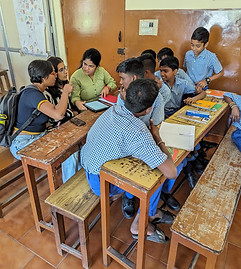
Context
We partnered with Resurrection High School for a two-week educational initiative facilitated by Paper Crane Labs. Our focus was to engage with sixth-grade students to develop an educational concept that encourages exploration of materials while enhancing their learning experience.
During my interactions with the students, I learned about the compulsory tailoring classes offered until the eighth grade. Many students, facing financial hardship, tend to drop out after completing the tenth grade. The skills acquired from these classes can serve as a means for supplementary income. However, I observed a lack of inclusivity in their environment.
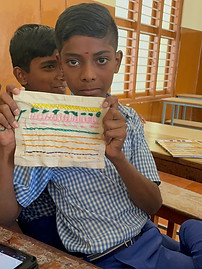
02 Ideate

My Take
While there is a need to create inclusive environments for individuals with disabilities, there seems to be a neglect of fostering an atmosphere of inclusivity for students categorized as 'abled.' This oversight raises questions about the broader definition of inclusivity and its practical implementation. The need for a dual perspective on inclusivity is evident—one that not only accommodates diverse abilities but also encourages everyone to adapt and connect meaningfully.
Concept
Incorporating Braille into eighth-grade stitching classes fosters creativity, awareness of visual impairments, inclusivity, diverse communication, and highlights the importance of accessible education.
02 Research
Braille Script
Size of Circle

Type of Thread
(Hover over elements for more )
Types of Stitch
Rhodes
French knot
Satin
Wooven wheel

I experimented with different stitch types and designed stencils in Adobe Illustrator, which were then used for laser cutting.

Stencils
04 Prototype
After conducting colaborative testing within the workshop group, participant feedback highlighted the necessity for a detailed, step-by-step instruction manual to enhance the clarity and coherence of the process. Consequently, I started creating the manual based on the feedback, marking the beginning of the first iteration.


I used a laser cutter to create stencils for various stitch types, simplifying the process of crafting intricate designs.
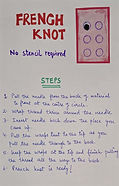

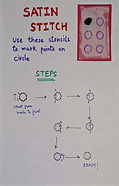.jpeg)
.jpeg)
Selected pages from the instruction manual (initial draft).
05 User Test
During playtesting with students from Resurrection High School, their grasp of the exercise's intent confirmed my initial doubts. As the students were not familiar with Braille, their preferences for stitches varied widely.

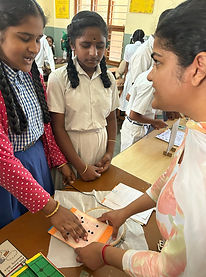

Feedback
-
More visual and intuitive step-by-step instructions are necessary for better comprehension.
-
Oral guidance remains essential to support the learning process.
-
Students encountered challenges when trying to trace points from behind the cloth.
-
There was uncertainty among students regarding the final objective of the exercise.
06 Refine
Design Enhancements

.jpg)
(Hover over elements for more information)

Material Upgrade
for
Improved Visibility
Switched from cloth to foam sheets to improve the visibility of the circle's points from the back, effectively addressing the shortcomings identified with the original fabric selection.
Task Simplification
for
Enhanced Clarity
Streamlined the task by concentrating on stitching one's name in Braille, which clarifies the objective and promotes a sense of achievement.
Manual Enhancement
for
Improved Usability
Revised the manual to improve clarity and comprehension, integrating user feedback from the playtesting phase to boost overall usability.
Refined Prototype
Foam Sheets
Embroidery Threads &
Needles
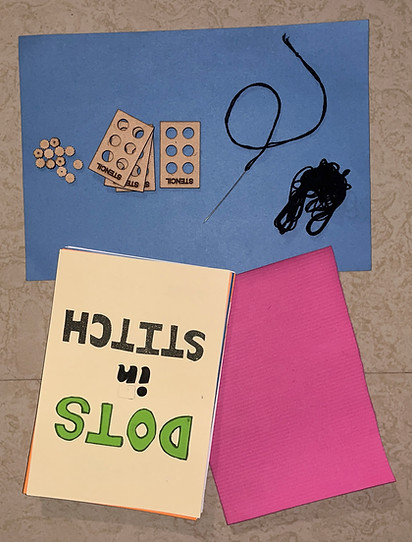
1
2
4
3
Instruction Manual
Stencils
Takeaways
Learnings
01
Hands-on journey through product design
Emphasized communication and effective pitch.
03
Designing for children requires comprehensive understanding
Addressing needs, concepts, functionality, and safety is challenging.
05
User testing is crucial
It helps eliminate assumptions and biases effectively.
02
Unconventional experimentation
Essential for understanding material properties deeply.
04
Maintain flexibility in design
Allow for adaptability and wiggle room.
Next Steps
(Hover over elements for more information)
Interactive Tutorials
Include interactive tutorials or an instructional video in the kit.
Themed
Projects
Create themed stitching projects based on different subjects or interests to provide context for Braille learning and make it more engaging for students.
Celebratory Milestones
When students reach specific milestones, include small celebratory elements or certificates to help them feel accomplished and motivated.
References
-
Braille Works. "History of Braille." Accessed October 18, 2023. https://brailleworks.com/braille-resources/history-of-braille/.
-
Sanjeev, Kumar, and Khagendra Kumar. "Inclusive Education in India." Electronic Journal for Inclusive Education 2, no. 2 (2007): Art. 7. Available at SSRN: https://ssrn.com/abstract=3499954.
-
Singal, Nidhi. 2005. “Mapping the Field of Inclusive Education: A Review of the Indian Literature.” International Journal of Inclusive Education 9 (4): 331–50. doi:10.1080/13603110500138277.
-
Jarjoura, W., and A. Karni. "Braille Reading in Blind and Sighted Individuals: Educational Considerations and Experimental Evidence." In Handbook of Arabic Literacy, edited by E. Saiegh-Haddad and R. Joshi, 9. Dordrecht: Springer, 2014. https://doi.org/10.1007/978-94-017-8545-7_18.
-
United Nations Development Programme (UNDP) Thailand. "Tweet." Twitter, January 8, 2023. https://x.com/UNDPThailand/status/1610496527268745216.









